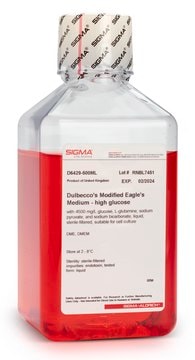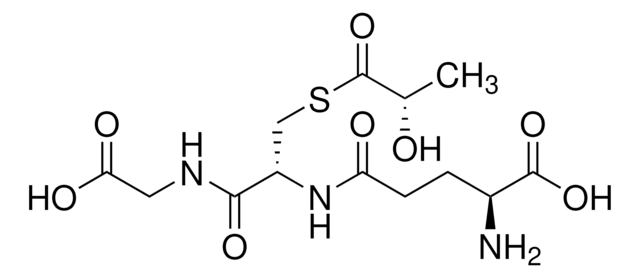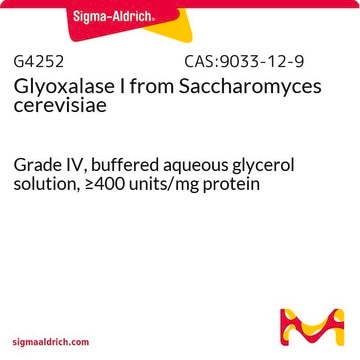Products may be shipped at a different temperature than the recommended long-term storage temperature. If the product quality is sensitive to short-term exposure to conditions other than the recommended long-term storage, it will be shipped on wet or dry-ice. If the product quality is NOT affected by short-term exposure to conditions other than the recommended long-term storage, it will be shipped at ambient temperature. As shipping routes are configured for minimum transit times, shipping at ambient temperature helps control shipping costs for our customers. For more information, please refer to the Storage and Transport Conditions document: https://www.sigmaaldrich.com/deepweb/assets/sigmaaldrich/marketing/global/documents/316/622/storage-transport-conditions-mk.pdf
M0252
Methylglyoxal solution
~40% in H2O
Sinonimo/i:
Acetylformaldehyde, Pyruvaldehyde, Pyruvic aldehyde
About This Item
Prodotti consigliati
Stato
liquid
Livello qualitativo
Concentrazione
~40% (enzymatic)
~40% in H2O
Densità
1.17 g/mL at 25 °C (lit.)
Temperatura di conservazione
2-8°C
Stringa SMILE
[H]C(=O)C(C)=O
InChI
1S/C3H4O2/c1-3(5)2-4/h2H,1H3
AIJULSRZWUXGPQ-UHFFFAOYSA-N
Cerchi prodotti simili? Visita Guida al confronto tra prodotti
Categorie correlate
Descrizione generale
Applicazioni
- to assess glyoxalase 1 (GLO1) enzymatic activity[3][4]
- as an advanced glycation end (AGE) forming agent for the preparation of albumin in vitro[5]
- to regulate anxiety like behavior in mice[6]
- to induce peritoneal fibrosis in rats[7]
- to study the chromatographic retention characteristics of organic chemicals and metal DNA adducts[8]
- for intraplantar injection in mice to investigate peripheral and central components of methylglyoxal (MG)-transient receptor potential ankyrin 1 (TRPA1)-adenylyl cyclase 1 isoform (AC1) pathway[1]
Avvertenze
Danger
Indicazioni di pericolo
Consigli di prudenza
Classi di pericolo
Eye Dam. 1 - Met. Corr. 1 - Muta. 2 - Skin Sens. 1
Codice della classe di stoccaggio
8A - Combustible corrosive hazardous materials
Classe di pericolosità dell'acqua (WGK)
WGK 1
Punto d’infiammabilità (°F)
Not applicable
Punto d’infiammabilità (°C)
Not applicable
Dispositivi di protezione individuale
Eyeshields, Faceshields, Gloves, type ABEK (EN14387) respirator filter
Scegli una delle versioni più recenti:
Possiedi già questo prodotto?
I documenti relativi ai prodotti acquistati recentemente sono disponibili nell’Archivio dei documenti.
I clienti hanno visto anche
Articoli
High-Performance Thin-Layer chromatography (HPTLC) quantification of methylglyoxal (MGO) in complex and matrix rich manuka honey offering quick sample preparation, high-matrix tolerance, and high-throughput.
-
How is shipping temperature determined? And how is it related to the product storage temperature?
1 answer-
Helpful?
-
-
How can I determine the shelf life / expiration / retest date of this product?
1 answer-
If this product has an expiration or retest date, it will be shown on the Certificate of Analysis (COA, CofA). If there is no retest or expiration date listed on the product's COA, we do not have suitable stability data to determine a shelf life. For these products, the only date on the COA will be the release date; a retest, expiration, or use-by-date will not be displayed.
For all products, we recommend handling per defined conditions as printed in our product literature and website product descriptions. We recommend that products should be routinely inspected by customers to ensure they perform as expected.
For products without retest or expiration dates, our standard warranty of 1 year from the date of shipment is applicable.
For more information, please refer to the Product Dating Information document: https://www.sigmaaldrich.com/deepweb/assets/sigmaaldrich/marketing/global/documents/449/386/product-dating-information-mk.pdfHelpful?
-
-
40%ということですが、25ml中10g程度のMGOが含まれるという理解でよろしいでしょうか。
1 answer-
The 40% approximation is mass/mass. In 25 grams of product, there will be 10 grams of methylglyoxal. The density of this preparation is 1.17 g/mL at 25 °C.
Helpful?
-
-
What are the mass and concentration of 25ML methylglyoxal solution?
1 answer-
As per the webpage of M0252: https://www.sigmaaldrich.com/product/sigma/m0252
The density is 1.17 g/mL at 25 °C (lit.). So the mass of 25 mL = 1.17 x 25 =29.25 g.
The concentration = Density x w/w% x 1000 / Molecular Weight = 1.17 x 40% x 1000 / 72.06 = 6.49 mol/L.Helpful?
-
-
Hi I am using this chemical for my research, could you please tell me the molarity of this solution?
1 answer-
The molarity of the Methylglyoxal solution is approximately 6.49 M. This value may be calculated as follows:
Molarity = Density x w/w% x 1000 / Mw = 1.17 x 40% x 1000 / 72.06 = 6.49 mol/LHelpful?
-
-
How to dilute methylglyoxal? What is the stock concentration?
1 answer-
The stock concentration will range from 4.89 M to 8.11 M, depending on the percent methylglyoxal - the specification ranges from 30 % to 50 %. The molecular weight of methylglyoxal is 72.06 g/mol.
Using the catalog density of 1.17 g/mL at 25 °C, the molarity would calculate to 6.49 molar for a 40 % solution (1,170 g/L × 0.40 = 468 g/L; 468 g/L divided by 72.06 = 6.49 M).
The actual % concentration is reported on the lot-specific Certificate of Analysis.
See the link below to access a specific lot or to review a sample Certificate:
https://www.sigmaaldrich.com/US/en/product/sigma/m0252#product-documentationThe solution is aqueous and may be further diluted in more water. If diluting with an organic solvent is preferred, ether or alcohols (i.e. ethanol, methanol) are also miscible with water.
Helpful?
-
-
Is the listed density, 1.17 g/ml, for the entire solution i.e. the Methylglyoxal in water or just the Methylglyoxal compound?
1 answer-
The density is 1.17 g/mL for the prepared solution.
Helpful?
-
Active Filters
Il team dei nostri ricercatori vanta grande esperienza in tutte le aree della ricerca quali Life Science, scienza dei materiali, sintesi chimica, cromatografia, discipline analitiche, ecc..
Contatta l'Assistenza Tecnica.
















